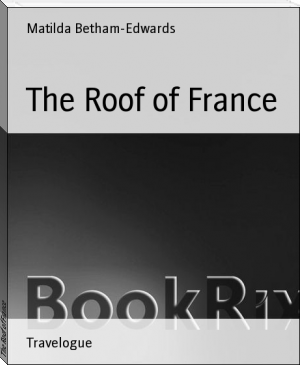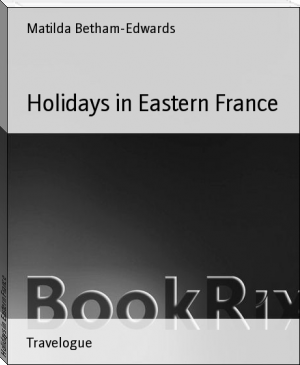The Roof of France by Matilda Betham-Edwards (which ebook reader TXT) 📕

- Author: Matilda Betham-Edwards
Book online «The Roof of France by Matilda Betham-Edwards (which ebook reader TXT) 📕». Author Matilda Betham-Edwards
During the long winter these fine roads, winding between steep precipices and abrupt rocks, are abandoned on account of the snow. The diligence ceases to run, and letters and newspapers are distributed occasionally by experienced horsemen familiar with the country and able to trust to short cuts.
What the icy blasts of January are like on these stupendous heights we can well conceive. At one point of our journey we reach an altitude above the sea equal to that of the Puy de Dome. This is the lofty plateau of granitic formation called Le Palais du Roi, a portion of the Margeride chain, and as the old writer before mentioned writes, 'la partie la plus neigeuse de la route'--the snowiest bit of the road. On this superb September day, although winter might be at hand, the temperature was of an English July. As we travelled on, amid scenes of truly Alpine grandeur and loveliness, the thought arose to my mind, how little even the much-travelled English dream of the wealth of scenery in France! Our cumbersome old diligence carried only French passengers. Nowhere else in Europe does the English tourist find himself more isolated from the common-place of travel.
Many of the landscapes now passed recall scenes in Algeria, especially as we get within sight of the purple, porphyritic chain of the Lozere. We gaze on undulations of delicate violet and gray, as in Kabylia, whilst deep down below lie oases of valley and pasture, the dazzling golden green contrasting, with the aerial hues of distant mountain and cloud.
Nothing under heaven could be more beautiful than the shifting lights and shadows on the remoter hills, or the crimson and rosy flush of sunset on the nearer rocks; at our feet we see well-watered dales and luxuriant meadows, whilst on the higher ground, here as in the valley of the Allier, we have proofs of the astounding, the unimaginable patience and laboriousness of peasant owners.
In many places rings of land have been cleared round huge blocks of granite, the smaller stones, wrenched up, forming a fence or border, whilst between the immovable, columnar masses of rock, potatoes, rye, or other hardy crops, have been planted. Not an inch of available soil is wasted. These scenes of mingled sternness and grace are not marred by any eyesore: no hideous chimney of factory with its column of black smoke, as in the delicious valleys of the Jura; no roar of millwheel or of steam-engine breaks the silence of forest depths. The very genius of solitude, the very spirit of beauty, broods over the woods and mountains of the Lozere. The atmospheric effects are very varied and lovely, owing to the purity of the air. As evening approaches, the vast porphyry range before us is a cloud of purple and ruddy gold against the sky. And what a sky! That warm, ambered glow recalls Sorrento. By the time we wind down into the valley of the Lot night has overtaken us. We dash into the little city too hungry and too tired, it must be confessed, to think of anything else but of beds and dinner; both of which, and of excellent quality, awaited us at the old-fashioned Hotel Chabert.
CHAPTER II. MENDE.
Mende was the last but one of French bishoprics and chef-lieux to be connected with the great highroads of railway.
That tardy piece of justice only remained due to St. Claude in the Jura when, owing to the Republic, Mende obtained its first iron road. Much time and fatigue will henceforth be spared the traveller by these new lines of railway, now spreading like a network over every part of France; yet who can but regret the supersession of the diligence--that antiquated vehicle recalling the good old days of travel, when folks journeyed at a jog-trot pace, seeing not only places, but people, and being brought into contact with wholly new ideas and modes of life?
The benefits of the railway in the Lozere and the Jura are incalculable from an economic point of view, to say nothing of the convenience and comfort thereby placed within reach of all classes. It is an English habit to rail at the lavish expenditure of the French Government. Cavillers of this kind wholly lose sight of the tremendous strides made during the last fifteen years in the matter of communication. Surely money thus laid out is a justifiable expenditure on the part of any State?
I lately revisited the Vendee after twelve years' absence. I found the country absolutely transformed--new lines of railway intersecting every part, increased commercial activity in the towns, improved agriculture in rural districts, schools opened, buildings of public utility erected on all sides-evidences of an almost incredible progress. In Anjou the same rapid advance, social, intellectual, material, strikes the traveller whose first acquaintance with that province was made, say, fifteen years ago. Take Segre by way of example; compare its condition in 1888 with the state of things before the Franco-Prussian War. And this little town is one instance out of hundreds.
It was high time that something should be done for Mende. No town ever suffered more from wolves and wolf-like enemies in human shape. Down almost to our own day the depredations of wolves were frightful. The old French traveller before cited, writing in 1816, speaks of the large number of children annually devoured by these animals in the Lozere. The notorious 'Bete du Gevaudan,' at an earlier period, was the terror of the country. It is an exciting narrative, that of the gigantic four- footed demon of mischief, how, after proving the scourge of the country for years, desolating home after home, in all devouring no less than a hundred old men, women, and children, he was at last caught in 1767 by a brave monster-destroying baron, the Hercules and the Perseus of local story. The ravages of wild beasts were a trifle compared to the enormities committed by human foes.
It is not my intention to do more than touch upon the religious wars of the Cevennes. Those blood-stained chronicles have been given again and again elsewhere. No one, however, can make a sojourn at Mende without recalling the atrocities perpetrated in the name of religion, and compared to which the excesses of the Jacquerie and the Terror sink into insignificance. If any of my readers doubt this, let them turn to the impartial pages of the eminent French historian, the late M. Henri Martin; or, to take a shorter road to conviction, get up the history of the Gevaudan, or of this same little town of Mende.
On a smaller scale, the horrors of the siege of Magdeburgh were here repeated, the Tilly of the campaign being the Calvinist leader Merle.
Devastated in turn by Catholic and Protestant, Royalist and Huguenot, Mende was taken by assault on Christmas Day, 1579, and during three days given up to fire, pillage, and slaughter. A general massacre took place; the cathedral was fired and partially destroyed, the bells, thirteen in number--one of these called the 'Nonpareil,' and reputed the most sonorous in Christendom--being melted down for cannon. All that fiendish cruelty and the demon of destruction could do was done. In vain Henry of Navarre tried to put down atrocities committed in his name. A second time Merle possessed himself of Mende, only consenting to go forth on payment of a large sum in gold.
The history of Mende is the history of Marvejols, of one town after another visited by the traveller in the Cevennes; and in the wake of the burnings, pillagings and massacres of that horrible period follows the more horrible period still of the guerilla warfare of the Camisards, quelled by means of the rack, the stake, and the wheel.
The Revolution, be it ever remembered, abolished all these; torture ended with the Ancien Regime; and, although M. Taine seems of opinion that the new state of things could have been brought about by a few gentlemen quietly discussing affairs in dress-coats and white gloves, we read of no great social upheaval being thus bloodlessly effected. At such times a spirit of lawlessness and vengeance will break loose beyond the power of leaders to hold in check.
The approach to Mende is very fine, and the little city is most romantically placed; above gray spires, slated roofs and verdant valley, framing it in on all sides, rise bare, brown and purple mountains.
The cathedral presents an incongruity. Its twin-towers, each crowned with a spire, recall two roses on a single stem, the one full-blown, beautiful, a floral paragon, the other withered, dwarfed, abortive.
The first towers over its brother by a third, and is a lovely specimen of Gothic architecture in the period of later efflorescence. The second is altogether unbeautiful, and we wonder why such a work should ever have been undertaken at all. Far better to have left the cathedral one- towered, as those of Sens and Auxerre.
The town itself would be pleasant enough if its aediles were more alive to the importance of sanitation. It never seems to occur to the authorities in these regions to have the streets scoured and swept. Just outside Mende is a delicious little mountain-path, commanding a wondrous panorama: although this walk to the hermitage of St. Privat is evidently the holiday-stroll of the inhabitants, accumulations of filth lie on either side. [Footnote: The same remark might be made by a Frenchman of the lanes near Hastings!] No one takes any notice. As Mende has without doubt an important future before it, let us hope that these drawbacks will not afflict travellers in years to come. The little capital of the Lozere must by virtue of position become a tourist centre; surely the townsfolk will at last wake up to the importance of making their streets clean and wholesome.
To obtain the prettiest view of this charming, albeit tatterdemalion, little city, we follow a walk bordered with venerable willows to the railway station. Here is seen a belt of beautifully kept vegetable gardens and orchards, all fresh and green as if just washed by April showers. These are the property of peasant-owners, who dispose of their crops here and at Langogne. As yet the good townsfolk are hardly alive to the benefits of a railway. One of our drivers complained that it ruined the trades alike of carriage proprietor, conductor, and carter; another averred that the local manufacture of woollen goods, formerly of considerable account, was at a standstill owing to the importations of cheaper cloths. These grumblers will doubtless erelong take a different tone, as the glorious scenery of the Lozere becomes more widely known and Mende is made the tourists' headquarters. Our hotel, situated in the middle of the town, offers good beds, good food, dirty floors, charges low enough to please Mr. Joseph Pennell, and a total absence of anything in the shape of modern ideas. The people are charming, and the house is a mousy, ratty, ramshackle place hundreds of years old.
It may be as well to mention that folk assured me I was the first English-speaking lady ever seen at Mende. A short time before no little excitement had been created by the appearance of six young Englishmen in knickerbockers, footing it with knapsack on shoulder. But lady- tourists from the other side of La Manche? Never! Be this as it may, it is as well for my country-women, if any follow me hither, to avoid insular eccentricities of dress. The best plan, before exploring wholly remote regions of France, is to buy the neatest possible head-gear and travelling-costume in Paris. Without meaning to be impertinent, bystanders will stand agape at the sight of any strangers, English or French. Even my young





Comments (0)